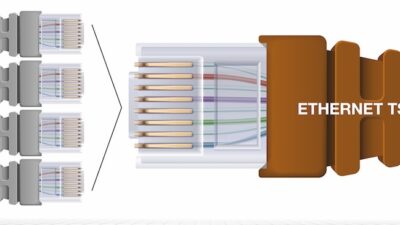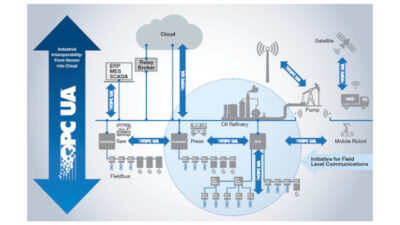Ethernet time-sensitive networking (TSN) gives users a secure and accurate way to communicate within industrial control systems (ICS) while delivering reliability and interoperability for critical communication.

Learning Objectives
- Understand the benefits of Ethernet time-sensitive networking (TSN) for manufacturers.
- Learn about its network flexibility and the ways it can help companies be more agile.
- Learn how organizations are collaborating to make Ethernet TSN more useful.
Ethernet insights
- Ethernet time-sensitive networking (TSN) is a set of IEEE standards that provides deterministic real-time communication.
- Ethernet TSN benefits include better network performance, flexibility, scalability and interoperability for users.
Ethernet time-sensitive networking (TSN) is a set of IEEE standards that provides deterministic real-time communication over Ethernet networks. It provides a reliable and low-latency network infrastructure for industrial control and automation systems, enabling real-time communication among devices in a network. Ethernet TSN offers several benefits for manufacturers, such as improved network performance, increased network flexibility and extended benefits for industrial communications.
1. Improved network performance using Ethernet TSN with TAS
Ethernet TSN provides deterministic communication, which means network traffic is delivered with a guaranteed latency and jitter. This is achieved by time-scheduling network traffic and reserving bandwidth for critical traffic. In traditional Ethernet networks, traffic is delivered on a best-effort basis, which can lead to unpredictable latency and jitter. This unpredictability can be problematic for real-time communication applications, such as control and automation systems, where timely data delivery is critical.
Ethernet TSN provides several mechanisms to achieve deterministic communication. One is time-aware shaper (TAS), which enables the prioritization of traffic based on the time-criticality of the application. TAS uses a time-based scheduling algorithm to ensure critical traffic is delivered with the required latency and jitter. This mechanism enables Ethernet TSN to provide low-latency communication, which is essential for real-time applications.
2. Increased network flexibility with Ethernet TSN
Ethernet TSN provides increased flexibility through the use of time-scheduling and reservation mechanisms. These enable different types of traffic to be prioritized and allocated bandwidth according to their requirements. This flexibility enables Ethernet TSN to support a wide range of applications with varying communication requirements.
Ethernet TSN also provides support for multiple traffic classes, which enables different types of traffic to be treated differently. For example, voice traffic can be given higher priority than data traffic, ensuring voice communication is not affected by network congestion. This flexibility is essential for applications where different types of traffic have different requirements.
Ethernet TSN also provides support for quality of service (QoS) mechanisms, which enables traffic to be allocated different levels of service. QoS mechanisms enable traffic to be prioritized based on parameters such as bandwidth, latency and jitter, ensuring traffic is delivered with the required level of performance. This flexibility enables Ethernet TSN to support a wide range of applications with different performance requirements.
3. Extending Ethernet’s benefits for industrial networks
Ethernet with TSN is extending the benefits of standard Ethernet, already so popular in industrial networking for several additional reasons:
-
Standardization: Ethernet is a widely adopted networking standard, which means it provides a common language and framework for different devices and systems to communicate and interoperate. This reduces the complexity and cost of integrating different devices and systems into one network.
-
Scalability: Ethernet is a scalable technology that can support large, complex networks with many devices and systems. This makes it valuable for industrial applications that require the integration of many different devices and systems such as factory automation, robotics and control systems.
-
High performance: Ethernet provides high-speed communication with low latency and high reliability, which is essential for many industrial applications that require real-time data exchange and control. This enables industrial networks to operate more efficiently and with greater precision.
-
Interoperability: Ethernet enables interoperability between different devices and systems from different vendors, which reduces the complexity and cost of integrating and maintaining industrial networks. This allows industrial networks to evolve and adapt to changing requirements and technologies without requiring major infrastructure changes.
Standardizing Ethernet TSN for companies
As additional vendors adopt the technology, it will be important all implement their use of TSN in similar fashions in order to coexist. To this end, leading vendors have created a consortium called the TSN Industrial Automation Conformance Collaboration (TIACC).
Avnu, CC-Link Partner Association, ODVA, OPC Foundation and Profibus International (PI) have collaborated to develop one common conformance test plan for the IEC/IEEE 60802 profile of TSN for Industrial Automation. By working together, these organizations seek to provide end users with confidence IEC/IEEE 60802-compliant devices will coexist at the TSN level on shared networks regardless of differences in manufacturers or automation protocols.
Ethernet TSN provides significant benefits over traditional Ethernet networks in terms of performance, reliability and flexibility. It is valuable for industrial control and automation systems and its use will increase in other industries as real-time communication becomes more critical.
Thomas Burke is Global Strategic Advisor at CC-Link Partner Association, a CFE Media and Technology content partner. Edited by Chris Vavra, web content manager, Control Engineering, CFE Media and Technology, [email protected].
Consider this
What benefits can Ethernet TSN provide your facility?



